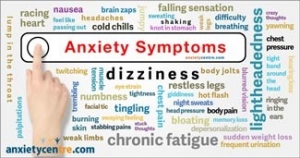Living with Anxiety
You don’t have to control your thoughts.
You just have to stop letting them control you. — Dan Millman
What does it mean to be living with Anxiety Disorder?
Living with anxiety is about more than feeling nervous or stressed on occasion. Those with anxiety are prone to intense feelings of being unwell and constant worry, even when nothing seems to be going wrong. This can lead to problems ranging from trouble sleeping to difficulty interacting with or being around others, even in situations like going to the grocery store. There are also several types of anxiety disorders, including generalized anxiety, social anxiety, and panic disorders.
Anxiety is rarely welcomed, but there is something of a relief when the cause can be pinpointed, like an upcoming job interview or school exam. For those with anxiety disorders, feelings of unwellness can often seem like a cruel joke. Everything might be going perfectly well in their day to day lives, but they cannot quell the sense something terrible is happening or is going to happen. They realize how irrational their thoughts are but still feel restless and afraid. Anxiety is not a mystery that can be easily solved.
What are the Symptoms?
Mood disorders are characterized by the lowering or elevation of a person’s mood. Anxiety disorders are characterized by excessive and persistent feelings of nervousness, anxiety, and even fear. Both types of disorders interfere with an individual’s everyday life for an extended period.
Anxiety disorders are often coupled with sleeplessness, depression, panic attacks, racing thoughts, headaches and/or other physical issues. Anxiety can run in families. Often, it is a lifelong challenge that spills over into all facets of life from relationships and parenting to the workplace.
Who does Anxiety Disorder Affect?
An estimated 264 million people worldwide have an anxiety disorder (Our World Data).
Mood and anxiety disorders are among the most common types of mental heath disorders in Canada. They have been shown to have a major impact on the daily lives of those affected. In 2013, an estimated 3 million Canadians (11.6%) aged 18 years or older reported that they had a mood and/or anxiety disorder. (Statistics Canada, 2014).
Managing Anxiety
The good news is that anxiety disorders are manageable. Counselors have multiple tools to help clients decrease the impact of anxiety. As a therapist, I often use the analogy of ocean waves with clients. Anxiety comes in waves and managing the disorder means learning coping tools and strategies to help surf those waves rather than expecting the waves to disappear entirely.
If you suffer from an anxiety disorder, research suggests that you may run a higher risk of experiencing physical health problems as well. So, when you manage your anxiety, you’re also taking care of your physical health.
Every person with anxiety is unique. While there is no guaranteed method that quells anxiety completely, everyone can find some relief in one or all of these approaches: psychotherapy, anti-anxiety medication, yoga, mindfulness meditation, and exercise.
Cristina Ahmadi Sagheb, MA, RCC
Family Therapist – Family Success Program

Langley Community Services is here to Help
Did you know Langley Community Services offers free counseling programs for Langley residents? Get help now. Click here for more information on our Counseling programs
Helpful Resources:
If you would like more information on Anxiety, please click on the following links:




